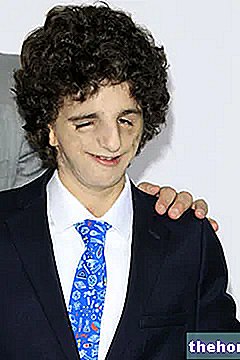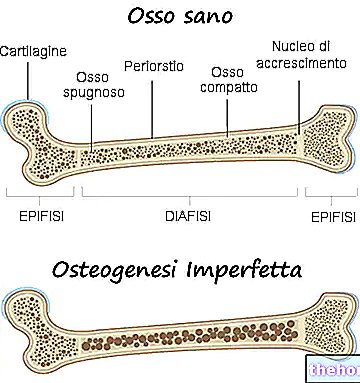What is Marfan Syndrome?
Marfan syndrome describes a complex hereditary disorder of connective tissue, primarily affecting the eyes, cardiovascular system and musculoskeletal system. However, considering that every organ is made up of connective tissue, Marfan syndrome can ideally destroy and heavily interfere with the growth and function of any anatomical site.
The syndrome is transmitted as an autosomal dominant trait: we are therefore faced with a serious genetic disease, having an extremely variable "phenotypic expression (the defects can differ enormously from family to family or from patient to patient).
What triggers the Marfan syndrome is the alteration of the FBN1 gene (on chromosome 15), which codes for fibrillin-1, a very important connective glycoprotein which constitutes the structural support for microfibrils.
Microfibrils: made up of fibrillin, microfibrils are present in the extracellular matrix, in which they form an intertwining for the deposition of elastin in the elastic fibers. Although ubiquitous in the body, microfibrils abound mainly in the aorta, ligaments and zonules of the ciliary bodies (at the ocular level).
As this is an autosomal dominant disease, only children who have inherited an altered FBN-1 gene from both parents are affected by Marfan syndrome. Nonetheless, in one out of four cases the disease is the result of spontaneous mutations in patients who do not have a family history.
The name of the disease derives from the French pediatrician who first described it in 1896 (A. Marfan), after which it was necessary to wait until 1991 to identify the altered gene involved in the symptomatological manifestation: the discoverer was F. Ramirez.
Watch the video
- Watch the video on youtube
Causes
We have mentioned that Marfan's syndrome is the immediate expression of the mutation of a gene that codes for fibrillin-1.
FIBRILLIN 1 is a glycoprotein component of elastin, essential for ensuring and maintaining tissue elasticity and strength. Under physiological conditions, fibrillin 1 binds to another protein, known as TGF-beta (or transforming growth factor beta). TGF-beta appears to be involved in deleterious processes affecting vascular smooth muscle and the extracellular matrix. Starting from these assumptions, some authors are convinced that Marfan syndrome is due, in addition to the mutation of the FBN-1 gene, also to an excess of TGF-beta, especially in the aorta, heart valves and lungs.

Incidence
It is estimated that Marfan syndrome affects 1 in every 3,000-5,000 births and occurs indiscriminately between males and females. Statistics show that 75% of patients have a positive family history; in the remaining 25% the cause lies in sporadic mutations which seem to be associated, in some way, with the father's advanced age at the moment of conception.
Children with extremely severe forms of Marfan syndrome have a "life expectancy of less than one year."
Before the evolution of open heart surgical strategies, most patients with Marfan syndrome had an average life expectancy of 32 years; thanks to the constant improvement of medical and pharmacological therapies, currently sufferers of Marfan syndrome live on average up to 60 years.
Signs and symptoms
For further information: Marfan Syndrome Symptoms
Marfan syndrome can occur completely asymptomatically. Affected patients have an exaggeratedly slender structure, being disproportionately tall and thin. The lower and upper limbs are much longer than the trunk (dolichostenomegaly). There is also talk of arachnodactyly to best express the concept of the exaggerated length of the fingers, typical of those affected by Marfan syndrome: the hands are therefore compared to the legs of a spider.
In terms of height, these patients have a stature with an average above the 97th percentile.
Among the other distinctive features often present in patients with Marfan syndrome, we also remember:
- Opening of the arms greater than the height
- Loose joints → exaggerated joint mobility
- Chest wall deformity
- Displacement of the lens
- Upper body less developed than the lower area
- Spontaneous pneumothorax (11%)
- Scoliosis
- Skin striae at the level of the thigh, back, deltoid, pectoral
Among the most problematic signs associated with Marfan syndrome, we remember the prolapse of the heart valve and the insufficiency of the mitral valve: a similar condition can easily favor the dilation of the aortic ring and aortic dissection.
The table shows the signs that can be found in Marfan syndrome patients. The characters described there are not always present, but a good part of them can be found.
Possible symptoms
Skin
Striae in the thoracic, lumbar and sacral area
Eyes
Vision alteration, astigmatism, retinal detachment, closed angle glaucoma, lens luxation, myopia
Bone structure
Arthralgia, kyphoscoliosis, dolichostenomelia (excessive development in length of the limbs relative to the trunk), hypermobility, high palate, deformed chest, flat feet, tight and thin wrists, abnormal re-entry / protusion of the sternum, scoliosis, curved shoulders, spondylolisthesis
Fingers
arachnodactyly
Lungs
Spontaneous pneumothorax, dyspnoea, idiopathic obstructive pulmonary disease
Facial alterations
Ogival palate (malformation of the palate), mandibular retrognathia (developmental defect of the jaw), elongated face
Heart
Angina pectoris, abdominal aortic aneurysm, cardiac arrhythmia, thoracic aorta dilatation / rupture / dissection, aortic insufficiency, mitral valve prolapse
Language
Difficulty with speech
Diagnosis
Considering the more than 200 possible mutations, the use of genetic markers is almost impossible for diagnostic purposes.
The assessment of Marfan syndrome is not always so immediate, since the phenotypic expression of the mutation is not always evident and easy to identify. The diagnostic delay can seriously compromise the patient's survival: just think, for example, of the failure to recognize a cardiovascular problem.
The diagnostic criteria for Marfan syndrome were drawn up internationally in 1996: the diagnosis consists of the "investigation of the family history associated with a combination of major and minor indicators of the syndrome.
Some of the numerous diagnostic tests used are:
- echocardiogram
- magnetic angioresonance and CT (for the investigation of the aorta)
- magnetic resonance angiography (MRA) with contrast fluid (to highlight the internal structures of the aorta)
- examination with slit lamps (to analyze the possible dislocation of the lens)
- ocular pressure measurement (to highlight the possible presence of glaucoma)
- genetic tests (recommended before conceiving a child to ascertain or not the syndrome)
Therapies
As this is a genetic disease, there is no drug or treatment that can reverse the disease.
The use of drugs is however essential to alleviate the symptoms and avoid any complications, especially cardiac complications. For this purpose, drugs to reduce blood pressure, such as sartans (above all), ACE inhibitors and beta blockers, are particularly suitable.
In the context of Marfan syndrome, patients also suffering from scoliosis can follow specific care, as well as for those affected by glaucoma.
Surgery is conceivable to correct the abnormal aortic dilatation, an element that often unites the majority of patients with Marfan syndrome.
Continue: Marfan Syndrome - Medicines and Treatment "




























